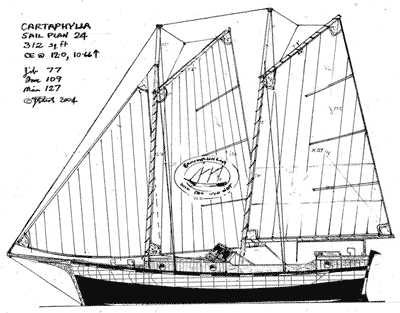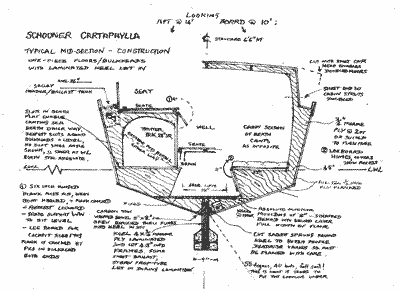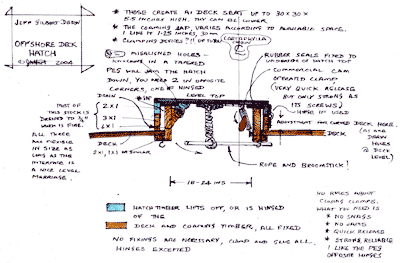Cartaphylla Seagoing Notes
I was having a good look at the cockpit. The six inches of
side deck could have a header tank under it -this could have
a large filler and bung below, & be used as a racing ballast
tank, one each side, bucket filled from the sea and dumped.
If the cockpit is to be truly comfortable & safe it wont
be built for a line of people sitting along the rail like ducks
in a shooting gallery. The tank equals the weight of one person.
The side deck stops at a coaming, up 9 ins and down 3 to 6 for
the seats which are 2 feet wide as is the well.

Interestingly it takes 55 degrees of heel to push the coaming
under, and the Cockpit well won't flood, just the outer seat
corner. This could be eliminated by bringing the coaming inboard
a bit, but it narrows the seats. It seems more important to
me to enable people to snooze full length in the cockpit. There's
not much point in designing a 6ft 6in long cockpit if you then
make the seats too narrow to sleep on. And do this to prevent
a situation that would probably only occur if you were less
than alert, through missing sleep. The amount of water shipped
is about 20 gallons which will drain out the well soon as you
get your boat back together, its the least of your worries,
staying on board is more important.
To heel 55 degrees takes a 40knot squall with full sail up,
& you are on max righting moment. Even if blown flat you
wont ship much more water, but you wont give a stuff about that
as you'll be busy trying to hang on as Cartaphylla almost immediately
pops back upright. In winds this strong your pre-storm procedure
should have been done. Lets suppose it isnt, you've been caught
by a 40 knot squall while sailing along gay as a bullfrog in
spring. This is how I think the boat should be handled.
-
check your lifeline is clear and clipped
onto, you have a light and knife tied on to you, and if poss.
an EPIRB & strobe.
-
Get to the mainmast and let go the halyards,ie
scandalise both mains(drop the gaff booms), by which time
the last of the water will be gurgling down the drain.
-
let go the steering and let her come up to
the wind.
-
if you have any crew set them to tying off
the main (sandwiched between its booms) and the fore (between
the gaff boom and the cabintop). You should have some shock
cords in the cockpit (octopus straps). If you have no crew
in the boat or floating locally, loop a shock-cord around
each sail and do the lashings later, last.
-
if they are prepped you can drop the jib
and raise the storm jib from the cockpit. If not see below.
-
secure all and keep sailing.
The Little Foredeck You Dont Go On!

berth cross-section (click to enlarge)
To keep sailing If your jib isn't ready you go
below and pop out of the fore hatch clipping onto the fore lifeline.
Unclip the jib and secure the end of its line to the bowsprit.
Bundle the jib below onto the Vberth flat which
should have the mattress already rolled up and in a bag for this
sort of sailing, The berth flat is painted with grip paint and
drains to the bilge.
The storm jib should be hanked onto its own stay at all times.Clip
it to its halyard and chuck its deck box lid below.
Clip on its sheet, with the storm jib still in its now lidless
draining box. Never take the lid off without clipping it on.
Tie off the jib stay lead and only go below after making all
secure, including all the foresail you can reach. You can reach
everything you need without going on deck.
If you have your boat really well prepared you'd have a canoe-style
canvas cape secured inside the inner hatch coaming, you pop
thru this with elastic round your waist. Not too tight, you
have to stuff 75 sq ft of jib past it, or pull the jib thru
behind you. Such a cape will save a lot of water entering the
cabin, less work for your bilge pump. Go below and fix the hatch,
go back to the cockpit, pull up the jib, tie it off tight and
get a bit of weigh on, then secure sails.
to lie ahull
-
just go forrd, get rid of the jib,
-
tie off a series drogue to the bow sprit and
feed it off the easiest bow side as best you can. This will
keep your bow into the waves and weather nicely.
-
secure all and go below to commune with your
Gods, whether they be in book or bottle.

hatch diagram (click to enlarge)
If you build the hatches to design you are now as safe as any
lifeboat. The hatches are seaway jobs, "leakproof"
& large at around 4 square feet (0.36 m2 , the foredeck
one a little smaller. They wedge from inside (use your imagination)
and have padlockable hasps out. I like them to jam on the coaming
so you can sail with them like that and throw one if someone
falls off, but many people don't like that as they water swelling
can make then jam, so I'll go with the majority vote on the
safe options. This means a simple gravity rubber seal and double
coaming, with drains in the outer coaming.
The cabin access means climbing down a ladder, I'm going to
design a single washboard companionway that wedges in very tight.
And I suggest carrying a tube of silicone sealant on the boat.
If you are in for a nasty storm, mastic and wedge the washboard
in. This is your weak point, crappy companionway boards washing
out was pinpointed as the biggest single cause of death in the
yachts knocked down in the 1978 Fastnet. The Investigating Committee
appealed to designers to take note, but designers draw for clients
who want easy access.
Cartaphylla has a mast step across the back of the cabin which
is also a cockpit seat and internal stow space. Its at cockpit
seat level and any companionway will be 6 inches above it, leaving
42 inches of ladder, steps, or oval hole-cum-step/hand holds
in the rear cabin bulkhead. Its safe, its good enough for a
million dollar 15m racing catamaran X-Factor just launched in
Auckland. Tim Clissold allows a sealing hatch and combined handhold/steps
as THE ONLY HULL ACCESS apart from the emergency hatch. Six
and a half feet down into the hull, thru this hatch about 18
ins square, and that's all she wrote. Despite an almost unlimited
budget, Tim has determined this is the only truly safe way.
Even though X-Factor is unballasted strip plank, and would float
swamped. Take note, if you are in a really bad way, perhaps
an injury, you will get into the cabin somehow. But you cant
call for help on submerged electrics.
Carts watertight access is easier, but even more necessary.
There is no point in full self righting if the boat, heavily
ballasted to achieve said self-righting on a shoal keel, comes
up full of water. End of story. If you want a wide companionway,
may as well make her a sharpie and get rid of the ballast so
she floats swamped. Admittedly we have www.turtlepac.com
,but this flotation is for emergencies such as a container holing.
We have a dry cosy cabin, lets preserve that because when you
really need it, soaked and half frozen, in a storm, you'll see
the integrity of access points as the most important aspect
of the boat. You may not put a foot wrong, but wind chill can
still finish you. Hypothermia. This cabin is a haven, and I'll
be finding a way to get a solid fuel heater in the Russian version.
I cant stop anyone changing the hatch design, but I wont help.
if you do change it, remember the sea can be like turning a
high pressure hose on your hatch. It better be good!
|

